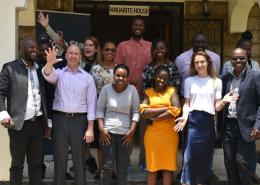The Table of Everything: A Scientist’s Quest to Make Human Genetic Data More User-Friendly

Since the human genome was first sequenced in 2003, scientists have collected a wealth of genetic information that could potentially be used to help create new medicines. Remarkably, as sequencing technology gets faster and cheaper, the amount of human genetic data now doubles every seven months.
But in order to keep pace with the rapid generation of genetic information and to make use of it in drug discovery, this information needs to be made more accessible for scientists of all stripes, not just the genomics experts who generate it. To help address this challenge for Pfizer scientists, Eric Fauman, a computational biologist, created the Table of Everything (ToE), a simple yet dynamic internal database that automatically updates weekly and catalogues almost 20,000 human genes and their related diseases and traits.
“It’s nearly impossible to keep up with all of the external data being generated,” says Fauman, Senior Scientific Director, Head Integrative Biology in the Internal Medicine Research Unit based at Pfizer’s Kendall Square, Cambridge site. Fauman’s ToE, resembling a search engine for genes, allows Pfizer scientists to quickly zero in on information related to a specific gene. Since the data sets in the ToE are curated by Fauman and his colleagues, users can be assured that they’re accessing accurate information. “It allows a Pfizer scientist to easily figure out which datasets have results of interest for their particular target,” he adds.

The ToE interface: Users can launch simple or sophisticated queries. Here, the portal displays human genes with expression in liver and a common genetic variant affecting LDL cholesterol and with a rare disease phenotype.
Fueling partnerships across the industry
As Fauman continues to update the portal to align with the evolving needs of Pfizer scientists, the ToE has also enabled Pfizer to collaborate with scientists across the industry. By sharing his learnings from establishing and maintaining the ToE internal database, Fauman has been able to contribute to the efforts of several industry-wide genetic databases, advising on what data sources should be added to their databases, as well as the look and feel of their portals.
Keeping databases of genetic information relevant for both the “high-intensity power users,” who want to dive deep into the data, and the “casual users,” who have basic genetic questions, is a challenge across platforms, he says. “We need to be able to cater to both of these sets of people,” says Fauman. “For most biologists, the question comes down to ‘show me everything about my gene related to a specific disease.’ These folks may only use a genetic information portal a couple times a year, so the tool has to be easy for them to be able to get an answer to that question.”

An example of a heat map generated by a related Pfizer portal based on genetic information in the ToE, showing the parts of the body where 20 different genes (shown on the horizontal axis) related to LDL-cholesterol are expressed. The areas in red represent high expression levels.
Human evidence
Many of the Pfizer ToE users, says Fauman, are scientists in early discovery who are hunting for new potential targets to treat diseases. Before genetic information became widely available, scientists had to rely mostly on cell-based and animal models to verify that their target is linked to a specific disease. While “you don't really know if a target’s going to work until you test it in clinical trials,” says Fauman, genetic data is helping to provide early supporting evidence. “Human genetics is this unique way of saying that ‘yes, in the human organism, which is what we actually care about, that gene is doing this thing.’”
To date, it is believed that only a handful of new compounds undergoing clinical trials across the industry have originated through genetic findings. However, as these new genetic-inspired compounds move along the development pipeline, experts are seeing if this approach can lead to higher success rates. “As this current cohort of genetics-inspired compounds works its way to the clinic, we’re testing the hypothesis that this approach leads to higher efficacy in humans,” says Fauman.





